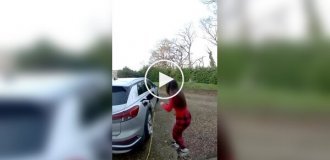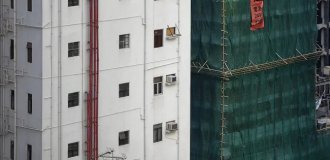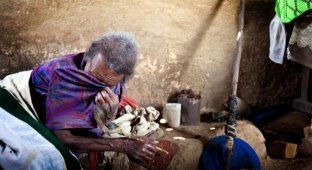Leper colony in Egypt (12 photos)
Although leprosy is now curable and is no longer very common, there are still leper colonies, or leper colonies as they are called, around the world. Abu Zaabal, an Egyptian leper colony 40 km from Cairo, was built in 1933. The police brought lepers here, who were not allowed to leave the colony, since isolation was considered the only treatment for leprosy at that time. Now the living conditions in this institution with all the necessary rooms are much better than in the poor villages where these lepers came from. That is why the colony's 750 patients and another three to four thousand cured lepers living in the neighboring village of Abdel Moneim Riad do not want to leave this institution. They may not be afraid of the stigma of shame and cruel insults in the back. This story is not about suffering and misfortune, but rather about the daily life of a microcosm in a godforsaken place, separated from the world. Even in Egypt, many people do not know about the existence of the Abu Zaabal leper shelter.


1. The Abu Zaabal leper colony in Egypt, 40 km from Cairo, was built in 1933; On its territory there is a hospital and an agricultural complex for self-sustenance. The bacteria responsible for leprosy were discovered in 1873 by Dr. Gerhard Hansen. The disease was considered incurable and highly contagious until the 1930s. If left untreated, leprosy can progress, affecting the skin, nerves, limbs and eyes. In fact, leprosy is not that contagious - approximately 95% of people are immune to it, and patients are no longer contagious after a couple of days after starting treatment. (Claudia Wiens)

2. The police brought lepers here, who were not allowed to leave the colony, since isolation was considered the only treatment for leprosy at that time. It was a large open air prison. In those days, the living conditions here were terrible - at night, mice gnawed at the wounds of the lepers while they slept. (Claudia Wiens)

3. In Abu Zaabal there is a larger ward for men and a smaller one for women, since women are less at risk of contracting leprosy. There are large and small sleeping areas, where each patient has his own bed and locker. There are also TVs in many rooms. Patients who lost legs or part of a leg as a result of the disease received new prostheses, which they are now learning to live with. Sometimes it is even difficult to distinguish a leg from a prosthesis. (Claudia Wiens)

4. To the cafeteria of Abu Zaabala, whose owner is a person cured of leprosy. Radhi is quite a popular place here. Effective treatment for leprosy, or leprosy, emerged in the late 1930s with the invention of dapsone and its derivatives. However, dapsone-resistant leprosy bacteria gradually evolved and began to spread rapidly. It was only after the discovery of multidrug therapy in the early 1980s that the disease could be recognized and successfully treated. (Claudia Wiens)

5. Sister Laura is the only nun from Egypt who has been working in the colony for five years as a nurse. Every morning she goes around to all the women, washes their wounds and calms them down, jokes and laughs with them. (Claudia Wiens)

6. Everyone who has the strength washes, cleans, cooks and helps those who do not have the strength. It's like a big family here. Sometimes someone argues about the tastes and ingredients of the food being prepared. Reminds me of ordinary life at home and those eternal arguments about who should peel the onions. (Claudia Wiens)

7. The women's part of the colony is separated from the men's by large gardens in which patients gather to relax and watch others. (Claudia Wiens)

8. About 1,200 patients live in Abu Zaabal and about 130 more come here for treatment. Seneya, 85, has lived here for more than 50 years. Although her legs and arms are deformed, she can walk and cook her own food. In conversation she is completely pure and open. She loves to sing, make fun of other, younger patients, and has a rather wicked sense of humor. (Claudia Wiens)

9. Photographer Claudia Vince was afraid to take photographs while patients were changing their bandages, but she was pleased with the calm atmosphere. The men talked to each other and even joked. This has long been a part of their lives, so they usually exchange news while the nurse cleans their wounds. (Claudia Wiens)

10. On the territory of the colony there is a large agricultural complex, used mainly for growing “tin shok”, cacti and some fruits. But over the years, the Egyptian government has been reducing the colony's territory more and more, taking away land. (Claudia Wiens)

11. A small mosque in the center of Abu Zaabal - everyone who can walk often comes here. Christian patients are visited regularly by a priest. (Claudia Wiens)

12. One of Abu Zaabal's largest sponsors, Caritas Egypt, founded a socio-medical center in the neighboring village of Abdel Moneim Riad in 1982. Their kindergarten educates about 120 children of lepers and former lepers. Children learn to read and write and receive one nutritious meal a day, including fresh milk. The therapist comes regularly. (Claudia Wiens)






















